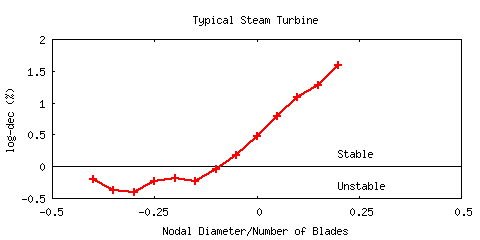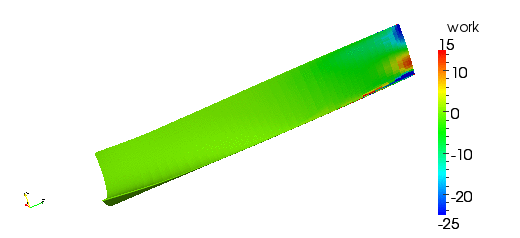Blade flutter is a major concern for designers of steam turbines
because it can lead to expensive blade failure.
The flutter risk can be assessed by calculating the logarithmic decrement (log-dec) of the
aeroelastic modes due to aerodynamic damping.
The log-dec is the rate of decrease in the blade vibration amplitude per cycle.
A log-dec plot created by averaging data from several large-scale
industrial steam turbines is shown below.
The log-dec plot is shown as a function of the nodal diameter of the aeroelastic modes.
The log-dec values shown in the plot were calculated assuming no mechanical damping.
Negative log-dec values indicate growth in the blade amplitude and a possible flutter problem
if there is insufficient mechanical damping.
The fact that the averaged log-dec values are negative for a large portion of the backward running modes (negative nodal diameters) highlights why flutter is a concern for the designers of steam turbines.

The blade motion for the aeroelastic modes can be assumed to be the same as the
in-vacuum structural mode shapes because the aerodynamic forces are small compared
with the structural forces.
Steam turbine blades are usually connected with each other by tip covers or snubbers.
As a result, the structural mode shapes are cyclic symmetric.
The mode shapes are complex with bending and torsion components
at different phases.
Also, the blade mode shape and frequency varies with nodal
diameter.
The most challenging aspect of predicting the log-dec of each aeroelastic mode is
calculating the work performed on the blades by
the unsteady flow induced by the motion of the blades.
The unsteady aerodynamic work can be calculated
by either time-marching a non-linear flow solver with the prescribed blade motion
or by solving the linearized flow equations.
A linearized flow solver delivers results just as accurate as a non-linear method because a single time
frequency dominates and the unsteady flow perturbations are small at the onset of flutter.
The figure below shows the unsteady work coefficient on a steam turbine blade
as calculated by a linearized flow solver.
Note that most of the unsteady work is done near the tip as
this is where the blade amplitude is largest
and the work is proportional to the square of the amplitude.

Another advantage of a linearized flow solver is that it is 100 to 1000 times faster
than conventional time-domain methods.
As a result, many more cases can be examined with a linearized flow solver.
A typical flutter study may examine hundreds of cases for various
nodal diameters, operating points, mode shapes, and blade geometries.
In general, the shape of the log-dec plot does not vary significantly from case to case
with the minimum log-dec value occurring near -N/2 nodal diameters, where N is the
number of turbine blades.
However, the minimum log-dec value can vary significantly from case to case (blade geometry,
operating point, mode shape) from positive stable values to unstable values less than -1.0 percent.
It is important that the minimum log-dec value for each case is determined as accurately as possible.
The minimum log-dec value is used to determine: